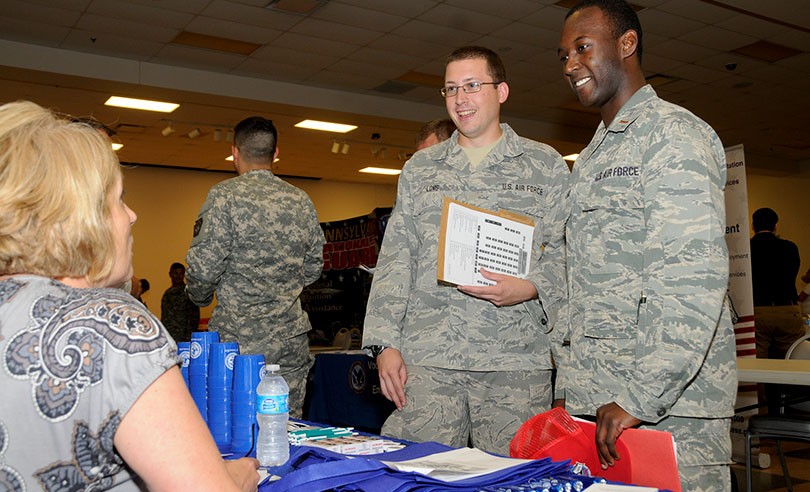5 Recruiting Strategies for Hiring More Vets
Any veteran who has successfully made the bumpy transition from combat life to civilian employment will be the first to tell you, it’s not easy translating military skills and experience neatly into employment opportunities in corporate America.
But as a hiring manager or recruiter, if you can master the complexities of placing former military personnel, you’ll have the advantage of tapping into a pool of tens of thousands of highly trained responsible, determined, loyal and quick thinking new hires.
Here are several recruiting strategies for hiring veterans, according to Dan Piontkowski, a veteran who is now a leader of the veteran recruiting efforts at KPMG US.
1. Don’t limit veterans to two jobs in your company
Hiring managers often pigeonhole veterans into two different types of jobs, such as operations and IT, explains Piontkowski. But the reality is that veterans are just like any diverse group of individuals who happen to come from a similar background, such as an ethnic group. “You would never say that a specific race can only do one specific type of job, and so in the same way, it’s limiting to believe that veterans are only good at certain types of work,” he says.
Veterans may all have certain soft skills in common, because they’ve been trained in the military, but that doesn’t mean they have the same functional skills. If you think vets are only a good fit for IT Security or operations, then you’re going to miss out on a lot of potential opportunities to hire veterans in finance or other areas, he says.
2. Throw your MOS translator in the garbage can
Although many recruiters are told to first look up a vet’s MOS code (Military Occupation Specialty code) using a translator application in order to make sense of their military background, Piontkowski thinks this is a total waste of time. Just because someone drove a tank in the military that doesn’t mean that’s going to apply to their career now.
What’s more important is talking to the vets and getting an understanding of their how much responsibility they had, says Piontkowski. “Instead of using MOS codes, ask questions; ‘how many people did you supervise?’ ‘How long did you do it?’ ‘What kind of budget were you responsible for?’”
In the military there is a direct correlation between how long you served and the level of responsibility you are given. So if you are looking to hire someone who has experience being in charge of a lot of other people, then you want to find someone with more years in service. The MOS translator codes may tell you what department they worked in, but it won’t really help you determine a candidate’s breadth of experience.
3. Think of it as sourcing, rather than recruiting
“Recruiters or hiring managers should attack the process more like a sourcing exercise rather than a recruiting effort,” says Piontkowski. In other words, instead of looking for the perfect candidate for a specific position, you want to get former military people in front of you first, and then figure out where they might be able to fit in well in your company.
“A recruiter looking to hire vets should go to H2H.jobs (Hero to Hired) to look for candidates,” he shares. He also encourages Fortune 500 companies to sign up with the 100,000 Jobs Mission, where they can access best practice resources.”
4. Pinpoint a manager to become the subject matter expert
Because of the complexities of understanding the military, Piontkowski suggests that one individual should be put in charge of overseeing the effort, and they should treat the military like a former employer, just as if they were hiring employees from any civilian company.
If your company is hiring mid-level supply chain positions, for example, you should make it a point to learn about supply chain communities in the military branches so that you can tap into that pool, he says. But you don’t need to understand everything about the military. For instance, he says, “don’t feel that you need to learn about the career track of a Combat Engineer in the Marine Corps, instead focus on the careers and communities that specialize in supply chain operations.”
5. Write better job descriptions
One of the biggest problems with hiring vets is that they don’t always know how they fit into civilian jobs, and that’s because most corporate job descriptions don’t use language that they can readily understand.
In order to write a job description that appeals to a vet, Piontkowski says you’ve got to describe the job in terms of “the purpose of the role.” For example, the job of a Solutions Architect has to do with helping bring two different departments together, finance and IT, in order to make decisions. But the description of a Solutions Architect is usually written as if you’re required to have stellar IT skills. “Once I understood what a Solutions Architect really was,” he says, “I realized it was the perfect position for a former captain or a lieutenant, but I never would’ve figured it out from the job description.”
Some companies are already doing a better job of writing job descriptions geared to military personnel, he says. Accenture is one company that has taken a really big step forward in that they spend time writing job descriptions that military personnel can understand, and will call out when having a military background is helpful for a particular job.
If your company is serious about hiring vets, it can definitely be done, says Piontkowski, “but it’s not just a switch that you flip on. You have to put in time and make a concerted effort.”
What other recruiting strategies do you use to hire veterans?
* image by Pennsylvania National Guard
Topics: Recruiting tips
Related articles




